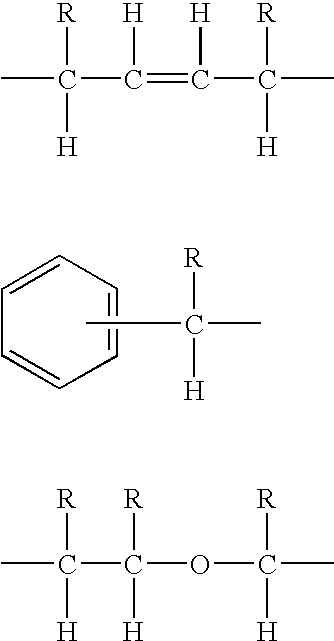Polyester/polyamide blend having improved flavor retaining property and clarity
a technology of polyamide and flavor, applied in the field of polyamide/polyester blends, can solve the problems of reducing useful scavenging capacity and no longer making practical sense to refer to induction period, and achieve the effect of enhancing the performance properties of the blend and high oxygen barrier
- Summary
- Abstract
- Description
- Claims
- Application Information
AI Technical Summary
Benefits of technology
Problems solved by technology
Method used
Image
Examples
example 1
[0134]This example illustrates the effect Components (B) and (C) on the color of a polyester composition made into a bottle.
[0135]Pellets of Voridian PET grade 9921W polyester polymer were blended with two versions of a polyamide of adipic acid and m-xylylene diamine, one version having carboxyl endgroups and the other version having amino endgroups.
[0136]The carboxyl terminated version (CT) was prepared by the following method:
[0137]In a 17 gallon stainless steel reactor vessel with a spiral agitator 33.17 lbs (110.73 moles) of m-xylylene diamine was added drop wise to a stirred mixture of 37.92 lbs (117.92 moles) of adipic acid and 63.6 lbs of water. The water was added to dissolve the salt and control the exotherm during its formation. A stoichiometric excess of 6.5 mole % acid was used to make about 60 lbs of a polyamide having an 0.29 Ih.V. The mixture was heated at 105° C. for 1 hour to remove the water. The temperature was then raised to 120° C. for 1 hour, and then to 135° C...
example 2
[0147]In this next set of experiments, the pellet blends of the polyamide pellets prepared according to the process described in Example 1 were combined with PET 9921W polyester pellets and cobalt as an oxygen scavenging transition metal catalyst according to the process described below, and then formed into a monolayer preform and stretch-blow molded bottles. The effects of the different polyamide polymers on the transmission rate of oxygen through the bottle wall and the induction period needed to commence significant oxygen scavenging were evaluated.
[0148]Dry blends were prepared using PET 9921W, commercially available from Eastman Chemical Company, 3.0 wt. % of the low molecular weight polyamide granules and pellets of a concentrate of cobalt catalyst in PET 9921. The catalyst concentrate was prepared by adding cobalt neodecanoate pellets to a PET 9921 melt stream on a twin screw extruder. The resulting pelletized concentrate contained about 3500 ppm Co. The mixture of PET 9921W...
example 3
[0153]This example illustrates the effect of only 1 wt. % predominately acid terminated polyamide and 100 ppm Co on the oxygen scavenging capability of the composition relative to a composition containing a polyamide predominately amine terminated. Samples were prepared and treated as described in Example 2, except the polyamide level was adjusted to yield 1 wt. % in the final blend. The oxygen transmission rates determined for these bottles are presented in Table 4.
[0154]
TABLE 4Oxygen transmission rates of 25 gram, 20 oz bottlesPET 9921W ControlWith 1 wt. % ATWith 1 wt. % CA(Without Polyamide)@ 100 ppm Co@ 100 ppm CoDaysOTROTROTRSince(cc(cc(ccBlowSTP / BottleSTP / BottleSTP / BottleMoldingday)Sampleday)Sampleday)Sample40.057120.047310.0500140.058510.050030.0482240.056930.050720.05113320.054930.04881——360.049820.046430.0491236————0.04461410.054310.049220.04173530.050510.04782——640.050830.046510.0491376——0.043530.0434181————0.0445295——0.04182——103——0.040610.04272109——0.039610.04272113————0...
PUM
| Property | Measurement | Unit |
|---|---|---|
| thickness | aaaaa | aaaaa |
| mean outer diameter | aaaaa | aaaaa |
| mean outer diameter | aaaaa | aaaaa |
Abstract
Description
Claims
Application Information
 Login to View More
Login to View More - R&D
- Intellectual Property
- Life Sciences
- Materials
- Tech Scout
- Unparalleled Data Quality
- Higher Quality Content
- 60% Fewer Hallucinations
Browse by: Latest US Patents, China's latest patents, Technical Efficacy Thesaurus, Application Domain, Technology Topic, Popular Technical Reports.
© 2025 PatSnap. All rights reserved.Legal|Privacy policy|Modern Slavery Act Transparency Statement|Sitemap|About US| Contact US: help@patsnap.com



